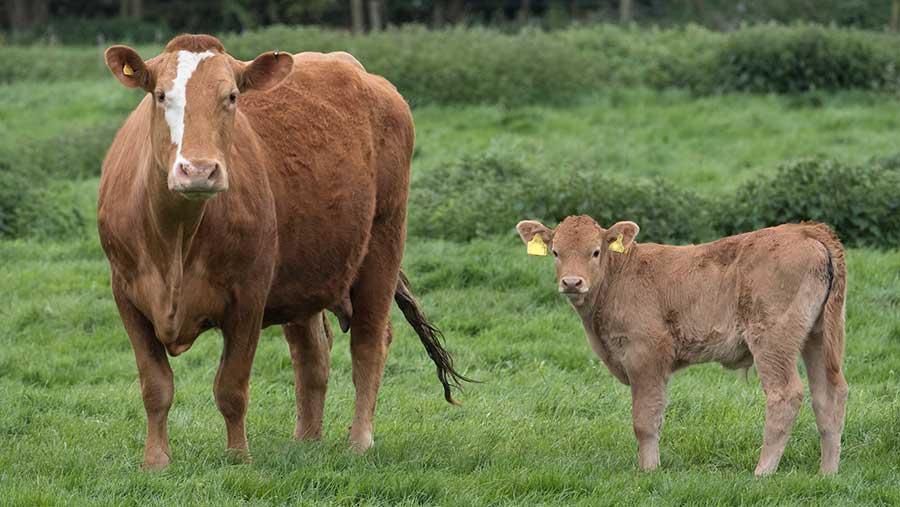Q&A: How to reduce the risk of grass staggers
 Recently calved beef animals are at high risk of grass staggers © Tim Scrivener
Recently calved beef animals are at high risk of grass staggers © Tim Scrivener Spring turnout can be a high-risk time for grass staggers, a relatively rare but very serious condition.
Warm and wet weather can heighten the risk further, so vigilance is key.
Farmers Weekly spoke to Charlotte Mouland, vet with Synergy Farm Health, Dorset, to find out what signs producers should watch out for and what actions to take in order to reduce the risk.
What is grass staggers?
Grass staggers, or hypomagnesaemia, is a metabolic disorder which can affect sheep and cattle. In cattle is relatively rare but it is a veterinary emergency if it does occur.
Hypomagnesaemia literally means low blood magnesium levels.
Magnesium is essential in many metabolic processes including energy production and muscle and nerve functions.
Unlike most other minerals, magnesium is not easily released from body tissues in times of high demand, so ruminants require a daily intake in their diet.
See also: Guide to preventing milk fever in your herd
The annual incidence of grass staggers in the UK is reported at less than 1% and recently calved beef animals make up a large proportion of those cases.
However, other ruminants are at high risk of developing the disease and reasonable steps should be taken to reduce that risk, particularly when spring turnout and warm, wet weather coincide.
What causes it?
Anything which reduces daily feed intake can pose a risk, be that bad weather or transport.
Young grass leys are high-risk pastures compared with mixed plant species pastures.
High levels of potassium and ammonia in the forage will also disrupt magnesium uptake from the diet – these levels can be a result of fertiliser application.
What effect can the weather have?
A warm, dry April followed by rain will mean a flush of grass growth creating a high-risk time for grass staggers.
Fast-growing grass is low in magnesium as well as being low in fibre, so it passes quickly through the gut, reducing the time for the absorption of nutrients.
What animals are most at risk?
The risk to individual cattle can vary depending on their stage of production.
Pregnant and lactating animals are at greatest risk of developing grass staggers as they will be losing magnesium in milk.
What clinical signs should be observed?
If an animal’s daily magnesium intake is not met, cattle and sheep can develop neurological signs such as:
- high head carriage
- twitching muscles
- staggering and paddling.
After this, they progress to being down where you may observe paddling of the legs.
However, finding one dead animal or indeed multiple dead animals, can often be the first sign.
It is important to remember all cases of sudden death should be reported to the APHA in order to comply with anthrax legislation.
When should you call a vet and what should you do while waiting for veterinary assistance?
Time is of the essence in saving lives when it comes to grass staggers and a vet should be called immediately if the condition is suspected.
Staggering cattle (and sheep) are a real health and safety risk, so first and foremost do not put yourself or others in danger when trying to treat these animals.
Contact a vet as soon as possible. Injectable magnesium can be given under the skin to affected animals, only if safe to do so, while waiting for veterinary assistance.
What can be done to reduce the risk?
The key to prevention of hypomagnesaemia at grazing is to ensure daily intake of magnesium is met.
Grass staggers is what we a call an “iceberg disease”.
For every clinical case we see, there are likely to be lots more animals at high risk.
Buffer feeding with extra roughage, such as straw or hay can be helpful in slowing gut transit (for more advice see ‘Options for magnesium supplementation’, below).
Longer-term prevention strategies include developing fertiliser policies that avoid creating pastures high in potassium or ammonia at key periods during the grazing season.
Also, consider using mixed species leys for grazing at-risk livestock. Discussing grass staggers prevention strategies with your vet is a good place to start.
Can you test for it?
If a problem is suspected then blood testing six to eight cows for magnesium will confirm if there is a herd problem.
What can be done to treat the condition?
Treatment with magnesium under the skin is effective in early uncomplicated cases. In more complex cases a vet needs to be called as there may be multiple issues to deal with.
Magnesium can also be added to the water and the pasture.
Any treatment strategies should first be discussed with your vet.
Options for magnesium supplementation
Mineral licks
- Pros Convenient to use
- Cons Difficult to ensure that all animals have taken in enough magnesium
Feeding mineralised concentrates
- Pros Easy to assess that each individual has been supplemented
- Cons It may be undesirable to supplement energy in the diet
Administration of intra-ruminal magnesium boluses
- Pros Ensures all individuals are supplemented for a number of weeks during the risk period
- Cons Labour-intensive to administer and may not always provide enough magnesium to meet demand
Adding soluble magnesium salts to water supplies
- Pros Convenient and inexpensive to administer
- Cons Can be unpalatable so follow manufacturer’s instructions on dilution
